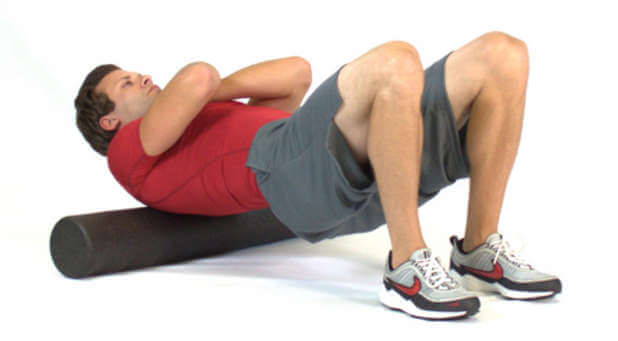Would you believe me if I told you that you could improve your flexibility, performance in workouts and function in everyday life, and reduce injuries all with a single piece of equipment that you can buy for less than $20? Well you should, because it’s true!
Self-Myofascial Release (let’s call it “SMR”) utilizes a simple yet brilliant little invention called a foamroller along with your own body weight to massage away yucky adhesions that form on important connective tissue that surrounds individual muscles, muscle bundles within individual muscles, nerves and blood vessels. This web-like, connective tissue, called fascia, often turns from soft and supple to tight and tender due to a variety of causes, such as immobility, injury, inflammation, exercise, stress and poor posture. Deep compressions on the fascia, through rolling, signals the muscle fibers to stretch, unknot and realign, thereby decreasing pain and increasing mobility as normal muscle length-tension is restored.
When performed correctly and consistently, SMR with a foam roller can be like a fantastic, free masseuse. I recommend foam rolling both before and after workouts, and even during sitting breaks at work or at your desk at home. Foam rolling before exercise (after your warm-up) is beneficial because it helps the two major receptors in your muscles—the muscle spindle responsible for contraction and the Golgi tendon organ responsible for relaxation—become balanced with one another, thus reducing injuries and increasing range of motion during your training.
Foam rolling again after you exercise is important too, as it lessens post-workout muscle soreness and expedites recovery. And finally, foam rolling any time of day, whether during your lunch break or right before bed, will effectively alleviate stiffness, help muscles return to their normal, healthy lengths, increase circulation and remove toxins.
Here are a few of my favorite foam rolling variations that can be done before and after just about any workout. Please note that it is always recommended to consult with your physician or physical therapist before starting SMR. Most people will be cleared immediately, and your doctor will likely encourage the practice.
Hips
Does your lower back hurt? Roll out your hips, because if your hips are stiff, you’ll find yourself bending at your waist during workouts and daily chores instead, which puts pressure on your lower back. Over time, this will lead to injury.
How to Roll
Sit on the foam roller with feet flat on the floor and knees bent. Hands are on the floor beside you.
Cross your right leg over your left, making a “4” with your legs. Rotate your hips to the right until you find a tight or painful spot. If and when you feel tightness, stop and hold for eight to 10 seconds.
Roll back and forth a few more times, then return to the spot and hold again. It will be painful, but pain is a sign that your muscles need this. Be diligent in foam rolling each day, and the pain will subside, I promise!
Move your hips forward and back to massage any more such areas for one to two minutes, then switch sides.
Upper Back
Thanks to desk jobs, as well as time spent in cars and on couches, most of us could use better posture, stronger shoulders, and less stiffness and upper back pain!
How to Roll
Sit on the floor with your knees bent. Place the foam roller behind you so that it’s perpendicular to your torso. Lie back, making sure the roller is under your shoulder blades.
Support your head with your hands and keep your knees bent and feet flat on the floor.
Lift your bottom so that your weight is supported by your feet and the foam roller.
Begin moving your hips up and down, keeping elbows squeezed together in front of your face. Again, when you find a tight spot, hold for eight to ten seconds.
Alternate rolling and holding for one to two minutes.
Inner Thigh
If your knees are giving you trouble, it’s likely due to poor stability in your hip joint and gluteus medius (one of the glute muscles responsible for internally rotating the thigh as well as pulling it away from the midline of our bodies), which is causing your iliotibial (IT) band to overcompensate during exercise. Many people foam roll over the wide strip of tendon on the outer thigh (the IT band) to try and loosen it, but this is often done in vain as the IT band is like a steel cable and could take what seems like millennia to improve.
If your knees hurt, try rolling the inside of your thigh to reduce inflammation in any muscles that may be pulling on your knee joint.
How to Roll
Position yourself so that one leg is turned out and the foam roller is under your inner thigh.
Pin your forearms to the floor in a shoulder plank position, and use your arms to roll up and down along the inner thigh. When you find a tight spot, hold for eight to ten seconds.
Continue this pattern for one to two minutes, then switch legs.
There are dozens of other foam rolling exercises out there, so I encourage you to ask a trainer, coach, physical therapist or well-informed friend for more suggestions. And now for a word on what kind of foam roller to use …
The cheapest foam rollers available are basic white ones made from polyurethane, the same kind of foam used in paint rollers. Though very affordable, they’re not the best choice, in my opinion, as they break down easily. If you’re brand new to foam rolling, I recommend an ethylene vinyl acetate foam roller, which is a bit softer, but won’t break down.
After you’ve been rolling for a while and feel ready to tolerate more pressure, it will be time to graduate to a “closed cell” roller, which is made of polypropylene. These are high density, so definitely more firm than the aforementioned options. Experienced foam rollers can even use a piece of PVC drainage pipe (about 4 inches in diameter is best). These are available at most hardware stores and are excellent to use on the upper part of the legs, as well as the calves.
As far as foam roller size goes, this will likely depend on how much space you have, but generally, the longer (36 inches) the roller, the better; a longer roller is easier to maneuver along your whole body. If you don’t have the space, or perhaps need a roller to pack with you while traveling, look for a shorter one that’s at least 6 inches in diameter.
Happy rolling! Stay fit, stay faithful.
Diana Anderson-Tyler is the author of Creation House’s Fit for Faith: A Christian Woman’s Guide to Total Fitness and her latest book, Perfect Fit: Weekly Wisdom and Workouts for Women of Faith and Fitness. Her popular website can be found at dianaandersontyler.com, and she is the owner and a coach at CrossFit 925. Diana can be reached on Twitter.
For the original article, visit dianaandersontyler.com.











































